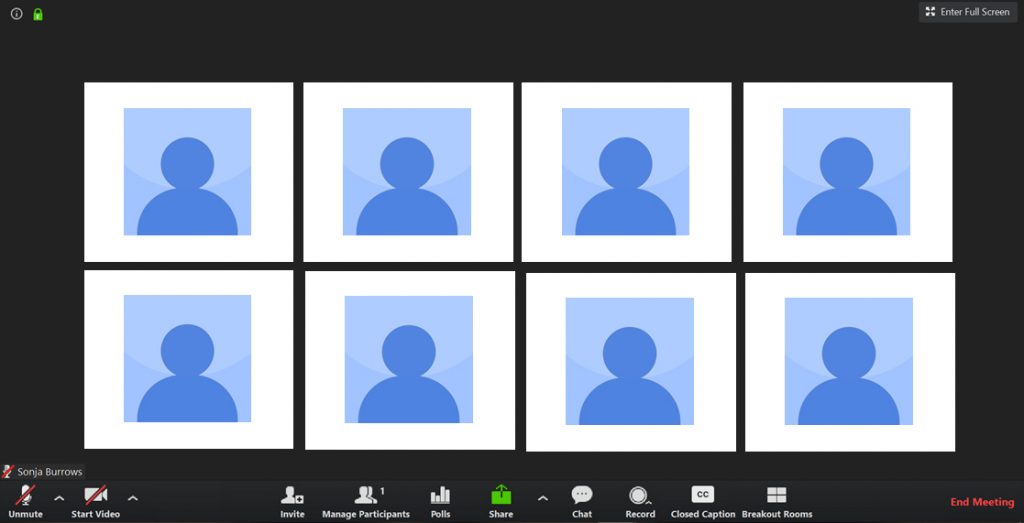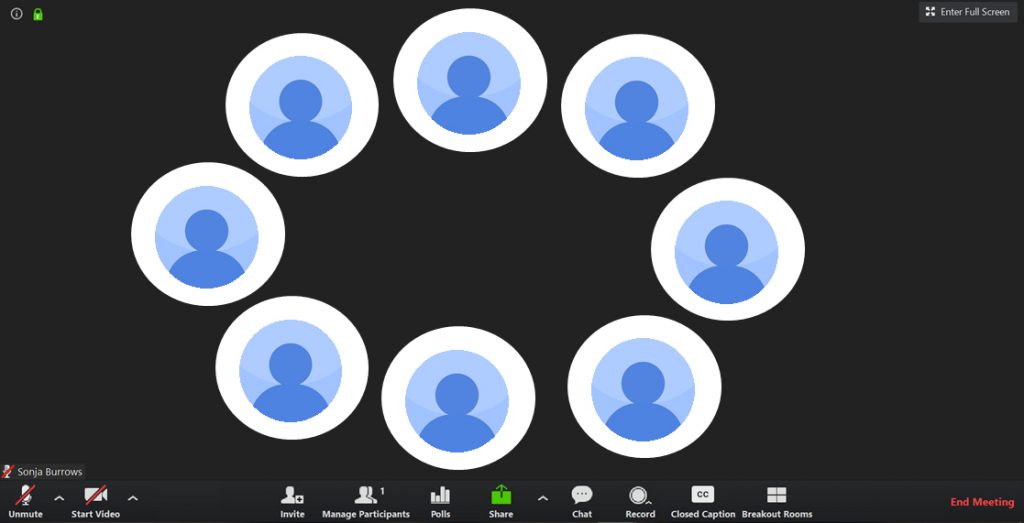What I Wish Zoom Could Do: Videoconferencing in the Time of COVID
By Sonja Burrows
The following piece was published in March of 2020, at the start of the Covid-19 pandemic.
These are extraordinarily challenging times, asking more and differently of humans and society than we had recently imagined would ever be asked. Among so many other hurdles and obstacles, many folks find themselves having to work remotely for the first time ever; furthermore, rather than being able to design this experience in advance, they have had no time to figure it out or to prepare for it, but rather are simply diving in out of sheer necessity. For other folks like me, who have been working on distributed teams for years and relying on digital tools to make that happen, this change represents nothing new. We have already acclimatized to the realities and constraints of collaborating digitally, have suffered and learned and made do and found ways to get it done.
And suddenly, with the global shutdown of in-person collaborations and the massive uptick in remote work as a result of the pandemic that is COVID-19, people like me find ourselves in a strange new position of holding a kernel of knowledge that the rest of the world needs, knowledge about how to reach across distance to join virtual hands with those not physically near, about how to connect, collaborate, about how to make this strange reality work. As an instructional designer at Middlebury College — where students were sent home last week and faculty were tasked with moving instruction online — I find myself, along with my colleagues in digital learning, all at once stepping up to train many, many others across our institution in gaining effective techniques to navigate this new way of working, collaborating, teaching, communicating and connecting. Welcome to our world!
I have long relied on an array of digital tools and platforms to make learning and collaborating possible across distance, with varying degrees of success. Videoconferencing tools such as Zoom, Skype, and Google Hangouts; instant messaging and team building tools like Slack; asynchronous communication streams like email, blogs and online forums; project management platforms like Asana, Smartsheets, Trello; learning management systems such as Blackboard, Moodle, Canvas and even Google Classroom; and, likely because these tools have often been solely responsible for how I get to connect with all of my colleagues (who currently reside on both sides of the United States), I have long wished these tools could do so much more than they actually do.
They could do so much more.
Zoom is awesome. It’s the best videoconferencing solution currently available in my opinion. As many people are learning recently, you can host meetings, webinars, classes, discussions and office hours using an extended array of features like screen sharing, chat, file transfers, breakout rooms, recordings, captioning, translation, polling and more. You can set a virtual background. You can control sound, visibility, and interactivity so as to promote the most effective experience for all. For whatever reason, connectivity seems to be less often an issue than with other videoconferencing platforms I have used.
And yet, there is something notably absent from the experience of connecting with Zoom. It’s just hard to feel like an actual person when you’re in Zoom. When folks join a Zoom call, they are confined to a sad little square box on the screen, which always rests on a black background. The more people who join, the more little square boxes crowd the grid of faces, and the smaller each square becomes until eventually participants get bumped off of your screen entirely. Yes, people may be smiling and talking and there may be children behind them, or a messy kitchen, or an overflowing bookshelf — all of which are lovely, humanizing elements of this experience — but each person is nevertheless stuck in that box, one square in a massive grid spread across your own screen. Everyone in Zoom lives in their own box, and depending on how you have configured your Zoom room, you may get to see only a few folks at once and it all depends on who is speaking.

Well, people are not squares, faces are not defined by right angles, and lives do not happen in a box. We may need to connect through screens but must we also confine ourselves always to a rectangle? It may seem like a small move but switching the profile view of Zoom users to circles — rather than squares — would be a step in the right direction. Please, Zoom, let us break out of the squares and grids! Visually altering the profile image of participants in Zoom from squares to circles would go a long way toward making the environment more welcoming. Perhaps even a user-generated choice as to whether to select squares or circles for visual representations would be a generous move toward a more welcoming visual connection space.
When I teach a class in a physical classroom environment, I love to make a circle or arc of chairs — and as the teacher, I always place myself in the arc or circle with students. I like to communicate with students when configured in this setting, because I find the assembling of people in a circle to be a very powerful, equalizing experience. Everyone has their place in the circle, and all voices are valued and heard when the physical room is configured to honor all. No one person or voice is given prominence by their physical position at the head of the room — unless, of course, you make the choice to create that experience by placing a chair physically in a prominent position such as at the front of the room. That’s a choice you can make through the positionality of the chair.
Can’t we do that in Zoom too? Imagine if the host of a Zoom call could configure all of the faces on the screen into a circle or an arc, and could rearrange them depending on the pedagogical value of doing so. You could choose a circle of faces if you so desired — perhaps for a large group discussion. Or, if it’s just a conversation with two people, they could be arranged to be side-by-side on your screen. And imagine if each person lived in a circle on the screen, not a hard square box. Imagine if we could break out of the grid, form groups, circles, pairs. Wouldn’t it be fun to “drag and drop” participants into different locations across your screen?

These are but a few small suggestions of the many I have about how to make Zoom a more human place to be. We can’t reach each other across physical space, but we can design that digital space where we get to connect to feel as welcoming and encouraging as possible. We have no choice but to use these tools, and use them we will to the very best of our ability, but the tools themselves can do so much more to be worthy of us. They can better help us to continue to be just exactly who we are in this moment: human beings working together across distance, against a backdrop of change, doing the best we can in the midst of a global crisis that is changing the way people live and work today and possibly for years to come.